Vegetables offer various flavors, textures, and health benefits. While many of us are familiar with common choices, there are countless varieties waiting to be discovered. Among them, let’s get to know those vegetables that start with the letter L!
Beyond the lettuce, there are 27 other vegetables that you can get to know. This article aims to spotlight these often overlooked or unfamiliar vegetables, as well as those that may be more familiar to us. From garden staples to exotic specialties, each entry brings its own unique taste and charm.
1. Lacinato Kale
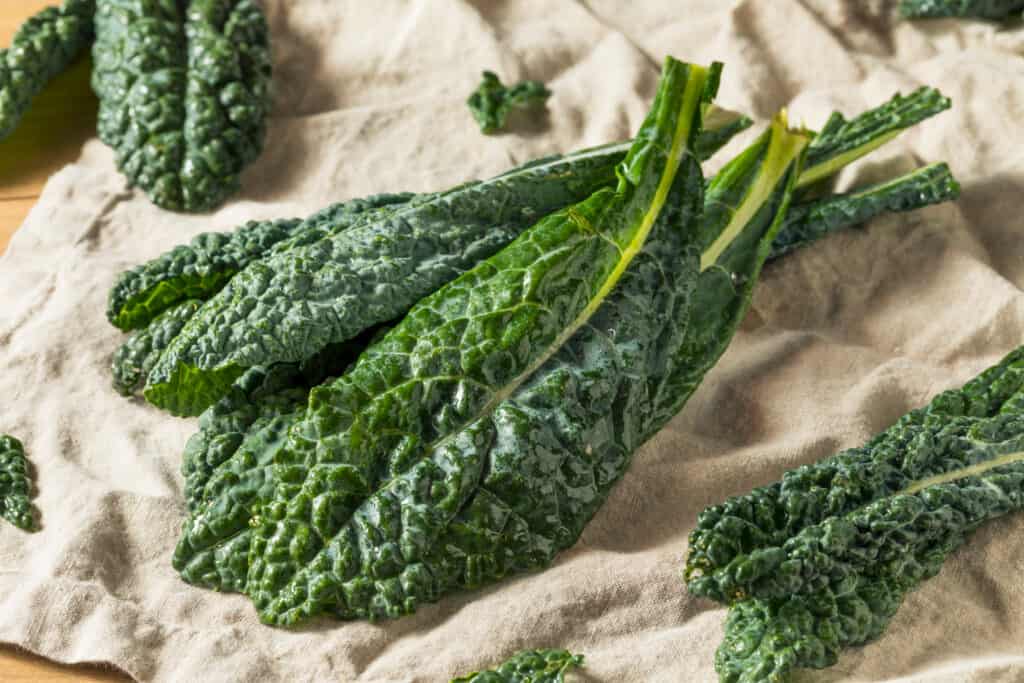
Also referred to as dinosaur kale due to the texture, lacinato kale is best enjoyed fresh.
©Brent Hofacker/Shutterstock.com
Lacinato kale is often referred to as Tuscan kale, black kale, or dinosaur kale. It’s part of the cabbage family, closely related to collards, broccoli, cauliflower, and of course, cabbage.
The distinct deep blue-green leaves possess a textured surface, similar to what one might imagine a dinosaur’s skin would feel like. This kale variety has a mildly sweet and nutty flavor, differing from the more bitter taste of its curly-leafed counterpart.
This type of kale is best enjoyed fresh, but it can also be cooked and still maintain its structure. While you can eat its stems, slicing them finely makes them more palatable.
This kale variety traces its origins back to Italy in the late 1800s.
2. Leeks
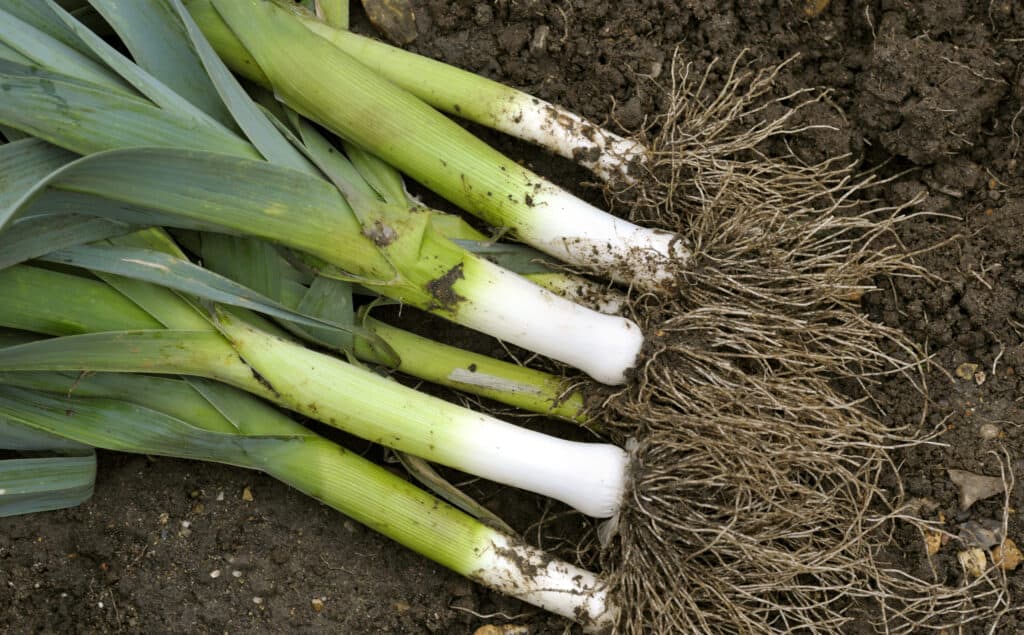
Of course, one of the most famous vegetables that start with L is the leek.
©Graham Corney/Shutterstock.com
Leeks, while bearing a resemblance to onions, have their distinct features.
Rather than growing a rounded bulb as onions do, leeks develop a fleshy and tender stem. They display a collection of flat, elongated leaves in shades from blue-green to yellow-green. Depending on the variety, these leaves can stretch a few feet, and the stalk might measure around 12 inches.
Tasting somewhat sweet, leeks echo the flavors of the Allium genus, which includes onions, garlic, chives, and shallots. In culinary uses, they can replace onions in dishes like soups and stews. Their gentler taste also makes them enjoyable raw.
Historically speaking, leeks trace their origins to the eastern Mediterranean and areas of the Middle East.
3. Lettuce

Probably one of the first vegetables you’ll think of when thinking of something that starts with L is the lettuce.
©Skrypnykov Dmytro/Shutterstock.com
Lettuce is a leafy vegetable that sprouts above the soil and is commonly cultivated in the US. Its plant has a modest stem, with larger leaves clustered at its base, getting smaller as they ascend. The leaves, either smooth or wavy, typically display shades of green or red.
With a crisp, cool, and sometimes tangy taste, lettuce offers a fresh touch to burgers and sandwiches. In salads, the nutrient-rich romaine variety is a favorite, while the crisp iceberg provides a delightful crunch.
Lettuce is among the earliest known vegetables. Originating in the Middle East, it made its way to China by the fifth century. Remarkably, it was also part of royal gardens in ancient Persia over two millennia ago.
4. Lima Beans

Another vegetable that starts with L is the lima bean.
©barmalini/Shutterstock.com
Lima beans, members of the legume clan, derive their scientific name, “lunatus,” from their crescent-shaped appearance.
These kidney-like seeds boast a broad, flat structure. Commonly found in a pale green or cream color, there are also varieties that show colors like white, purple, and even black.
Offering a unique combination of a buttery texture and a savory, vegetable-like flavor, lima beans stand out among other legumes. They fit seamlessly into soups, blend with various vegetables, accompany meat dishes, or serve as a distinct side dish, responding well to cooking techniques such as boiling, baking, and microwaving.
Lima beans have historical ties to South America, particularly Peru and the southern regions of North America.
5. Long Bean

Yardlong beans or long beans are slender and longer than the similar green bean.
©Melada photo/Shutterstock.com
Long beans have ancient roots, with their wild counterparts still found in parts of tropical Africa today. They are also referred to by names such as the long-podded cowpea, snake bean, asparagus bean, or Chinese long bean.
Their appearance is similar to the familiar snap bean but with a notable difference: they are slender and can stretch up to a meter or yard in length. Unlike the sweeter green bean, they boast a robust flavor with a marked bean-like taste. These beans shine when steamed, stir-fried, or braised, and they’re also a robust addition to hearty stews.
Historical references to this bean can be found in Chinese texts dating back to the Song Dynasty around 1008 CE, though it’s not definitively known if China is their place of origin.
6. Land Cress
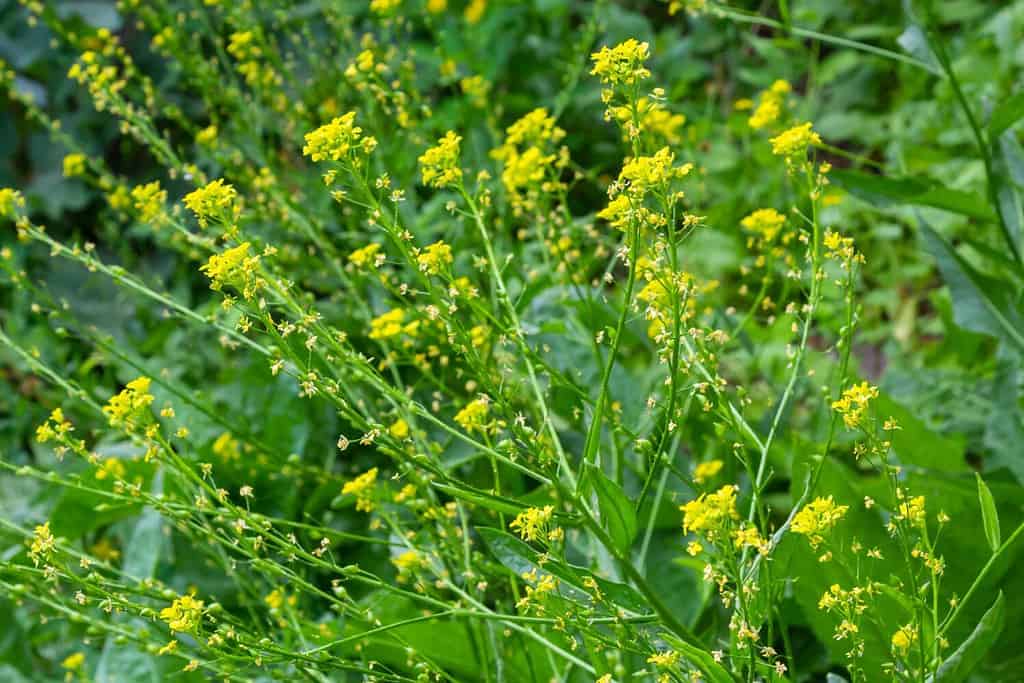
You can eat the yellow blooms of the land cress as well.
©olko1975/Shutterstock.com
Land cress, a biennial leafy green, belongs to the cabbage family and bears a resemblance to watercress with its petite square leaves.
Often dubbed as American land cress, this speedy-growing salad green can be ready to harvest in just a few weeks. It offers a taste similar to watercress.
You can enjoy its leaves either cooked or fresh in salads. And just like its brassica relatives, its yellow blossoms are delightful additions to meals. The leaves are versatile, enhancing salads, sandwiches, soups, pasta sauces, curries, and dishes like spanakopita.
Hailing from Southern Europe and Western Asia, land cress has expanded its presence globally. It’s worth noting that it has been a popular green in the UK since the 17th century.
7. Lemongrass
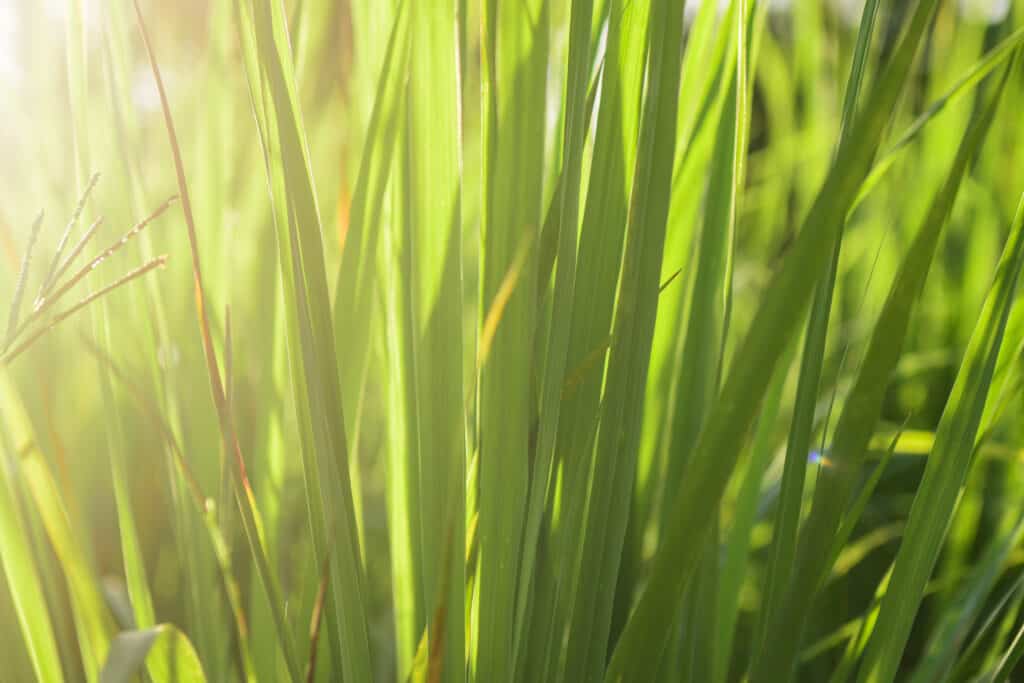
A staple in Southeast Asian cuisines, lemongrass is another vegetable that starts with the letter L.
©iStock.com/ATP-Photographer
Lemongrass is a staple in Asian kitchens, specifically in Southeast Asia.
This grassy herb is easily recognized by its yellow-green stalks and distinctive citrus aroma. Its appearance might remind one of green onions due to its bulb-like base, but the stalks are notably firm and woody.
The flavor profile of lemongrass is both unique and delightful. It offers a hint of sweetness combined with a tang reminiscent of lemon, and you might even detect a touch of ginger. Despite its distinct taste, it’s subtle enough to enhance dishes without overshadowing other flavors. To make the most of its tough texture, lemongrass is typically minced or mashed before use.
Lemongrass primarily finds its origins in regions of South Asia, Southeast Asia, and Australia.
8. Lentils

A type of legume, lentils have been around since ancient times.
©iStock.com/pawel_p
You might find it unexpected, but the USDA Dietary Guidelines categorize lentils as vegetables.
These tiny seeds come from the lentil plant, a member of the legume family. While beans, their legume cousins, can be eaten fresh, lentils are always consumed after drying post-harvest. Each lentil type has its unique color, size, texture, and flavor. Thus, selecting the right variety can make all the difference, ensuring a creamy lentil soup or a crunchy lentil salad.
Boasting a subtle, earthy taste with a nutty undertone, lentils are less pronounced in flavor than beans.
Native to Western Asia, lentils have been a part of ancient culinary traditions, such as those of Rome and Egypt.
9. Lamb’s Quarters
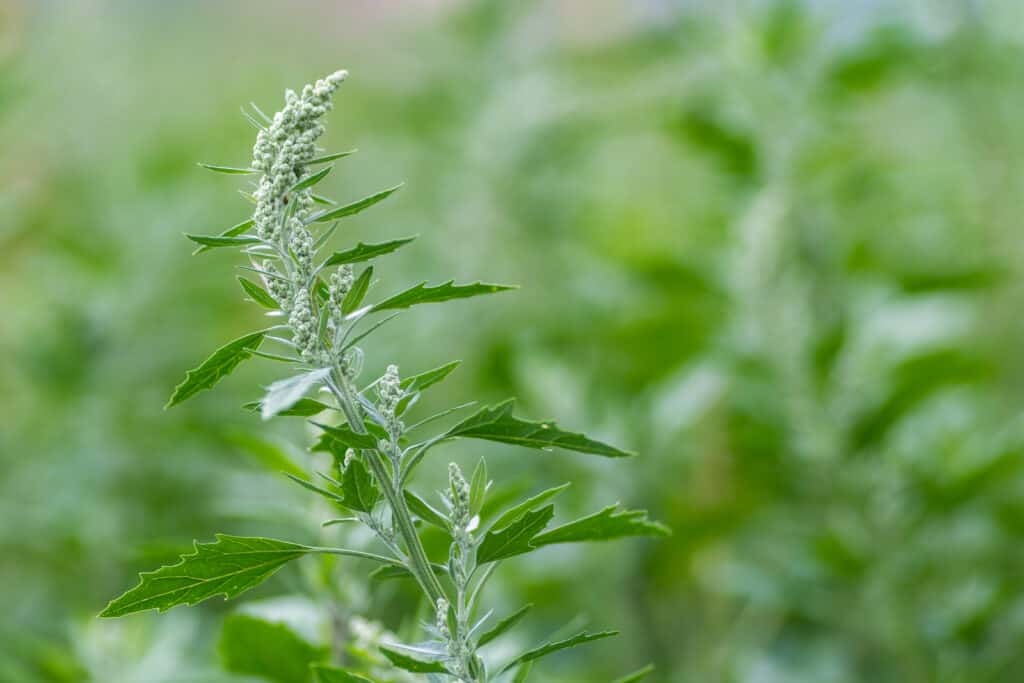
A leafy green vegetable that can grow up to 7 feet tall, lamb’s quarters is another vegetable that starts with the letter L.
©Arkadiusz Kolos/Shutterstock.com
Lamb’s quarters is a leafy green that commonly sprouts in freshly tilled soil alongside roads and even in waste areas. The plant can reach impressive heights, up to seven feet, and typically sports deep-green leaves, somewhat resembling the foot of a goose.
What sets this green apart from other wild edibles is its consistent mild taste, similar to spinach, which doesn’t turn bitter as the plant matures. Its seeds can be ground and used to fortify flour, enhance bread, or even in porridge. It’s essential to ensure the soil from which lamb’s quarters is harvested is clean and fit for growing food.
Whether fresh or cooked, lamb’s quarters can seamlessly replace spinach in various recipes, be it in soup or in pasta or egg-based dishes.
This vegetable enjoys a widespread presence across Asia, Europe, and North America.
10. Lotus Root
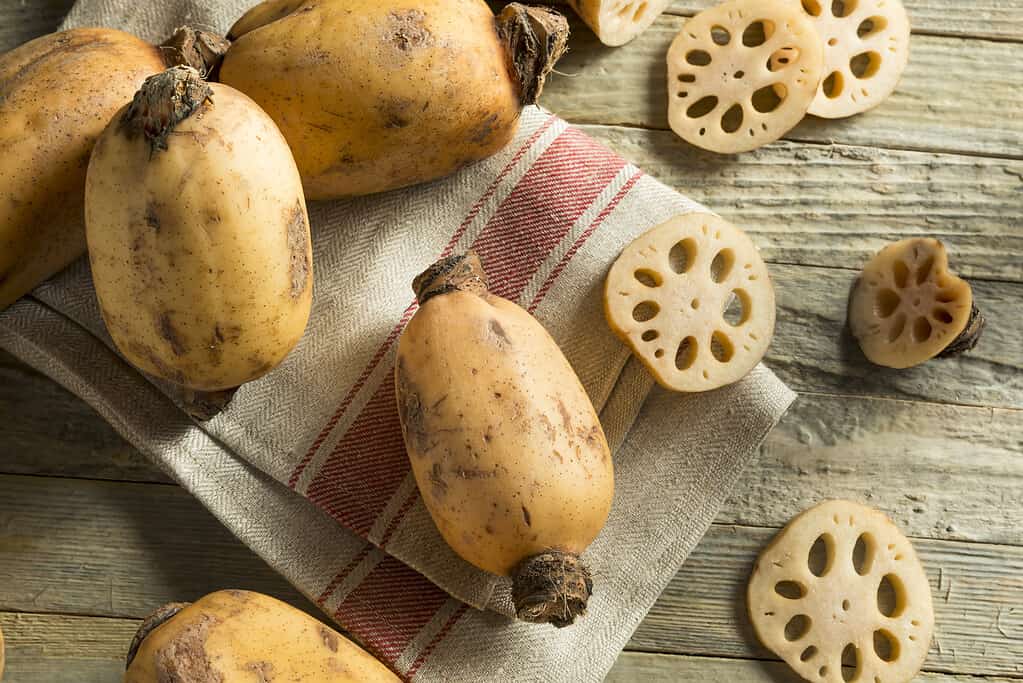
Popular in Asian cooking, lotus root grows underwater and looks almost like a squash on the outside.
©bhofack2/iStock via Getty Images
The lotus root thrives underwater and looks somewhat like a squash. On the outside, it appears as a cylindrical brown entity, but a cross-sectional slice reveals a pattern of interconnected holes.
When fresh, the lotus root offers a slightly sweet taste and a texture that’s a blend of jicama and celery. As it cooks, its consistency softens yet maintains a hint of its inherent crunch and characteristic subtle flavor.
Popular methods to prepare lotus root encompass deep-frying, stir-frying, or incorporating it into soups and stews.
This vegetable is native to New Guinea, Australia, Asia, and some parts of the Middle East.
11. Lady Finger

Lady’s finger, or okra, is another popular vegetable that starts with the letter L.
©Lahore Qalandars7/Shutterstock.com
Okra, often referred to as lady’s finger, is a plant that produces edible pods.
This vegetable is recognized for its long, slender form and the ridges gracing its exterior. It’s best picked when young and tender since maturing pods can turn hard and stringy. The tapered end of the lady’s finger is edible, but its pale green cap isn’t and is usually discarded.
Its subtle flavor and velvety texture make it versatile in the culinary world and suitable for boiling, frying, or pickling.
While the exact roots of okra remain a subject of debate, its origins could be traced back to West Africa or perhaps Southeast Asia.
12. Lo Bok

Another Asian vegetable that starts with the letter L is lo bok, a type of radish that gives dishes a crispy and fresh taste.
©alex5248/iStock via Getty Images
Lo bok, a prominent Asian vegetable, is a type of radish frequently found in Asian cuisine.
With its appearance like an oversized white carrot, lo bok offers a range of textures and tastes, much like other radish types. Its crispy and invigorating nature can transform based on its preparation method.
Whether consumed raw in salads, pickled, stir-fried, braised, or boiled, lo bok is versatile. Additionally, it’s a favored ingredient in various soups and stews.
This radish’s roots extend back to ancient China.
13. Lamb’s Lettuce

Native to Europe, North Africa, and Western Asia, lamb’s lettuce has a nutty and tangy flavor that is perfect for salads.
©a-lesa/iStock via Getty Images
Lamb’s lettuce, also known as corn salad or mache, belongs to the honeysuckle family.
This plant grows close to the ground, producing clustered rosettes that grow up to 11 inches tall. These rosettes have multiple layers of 6 to 8 elongated, rounded leaves. Also, these leaves vary in shape depending on the variety, from somewhat spoon-like to broad with a subtle point.
With its delicate, nutty, and slightly tangy flavor, lamb’s lettuce is best enjoyed fresh. Due to its tender and velvety texture, it’s not suited for high-heat cooking. Just like spinach, it’s essential to rinse the greens thoroughly before eating, as they can trap bits of soil and grit.
Lamb’s lettuce is native to Europe, North Africa, and Western Asia, where it has grown wild since ancient days.
14. Lakota Squash
Lakota squash is a captivating member of the winter squash family. Its vibrant and reddish-orange skin sets it apart from other squash varieties. It boasts a shape resembling a teardrop, which makes it a great fall decoration as well.
The flesh of the Lakota squash is sweet and velvety, with a nutty undertone. This makes it an excellent choice for roasting or pureeing into soups and pies. Its rich, deep flavor distinguishes it from other squashes and makes it a delightful addition to fall and winter recipes.
Like all other squash, Lakota squash is descended from a wild South American vegetable thousands of years ago.
15. Lovage

An aromatic herb, the lovage boasts a bold and savory taste.
©Lubos Chlubny/Shutterstock.com
Lovage, an herb with a distinctive and aromatic presence, boasts lush, dark green leaves and hollow stems. It looks very similar to celery, though its flavor is notably different. When mature, this vegetable bears yellow flowers.
Lovage has a bold and savory taste, with hints of celery, parsley, and a touch of anise. The leaves and stems can be used in a variety of dishes, including soups, stews, and green salads. Its flavorful addition can elevate the taste of these dishes, giving them a unique and refreshing twist. Even the roots and seeds are edible.
Lovage is a native vegetable in the Mediterranean region as well as Southwest Asia. This vegetable has grown in this region since ancient times and was even used by the ancient Greeks and Romans.
Comprehensive List of All Vegetables That Start with L
- Lacinato Kale
- Leeks
- Lettuce
- Lima Beans
- Long Bean
- Land Cress
- Lemongrass
- Lentils
- Lamb’s Quarters
- Lotus Root
- Lady Finger
- Lo Bok
- Lamb’s Lettuce
- Lakota Squash
- Lovage
- Lobster Mushrooms
- Lawyer’s Wig Mushroom
- Lion’s Mane Mushroom
- Loroco
- Lupin Beans
- Laver
- Lemon Drop Pepper
- Lengkuas
- Likok
- Lagos Bologi
- Lipstick Pepper
- Long Squash
- Lollo Rosso
Summary of the Highlighted Vegetables That Start with L
| Number | Vegetable | Benefits |
|---|---|---|
| 1. | Lacinato Kale | Vitamins C, K, and B6, calcium, copper, and magnesium |
| 2. | Leeks | Vitamins C, A, B1, B2, B3, and B9, folic acid, and fiber |
| 3. | Lettuce | Vitamins A, K, and C, potassium, calcium, and fiber |
| 4. | Lima Beans | Vitamins A and K, zinc, iron, potassium, calcium, and magnesium |
| 5. | Long Beans | Vitamins A and C, iron, potassium, magnesium, folate, and phosphorus |
| 6. | Land Cress | Vitamins B and E, calcium, and iron |
| 7. | Lemongrass | Vitamins C and A, iron, calcium, potassium, and magnesium |
| 8. | Lentils | Vitamins A, E, and K, zinc, iron, potassium, and magnesium |
| 9. | Lamb’s Quarters | Vitamins C and A, copper, calcium, magnesium, and iron |
| 10. | Lotus Root | Vitamins C and B6, iron, zinc, potassium, copper, and phosphorus |
| 11. | Lady Finger | Vitamins C, B, and A, zinc, calcium, fiber, and folic acid |
| 12. | Lo Bok | Vitamin C, iron, calcium, and fiber |
| 13. | Lamb’s Lettuce | Vitamins B6, A, C, and K potassium, and iron |
| 14. | Lakota Squash | Vitamins A and C, fiber, potassium, and magnesium |
| 15. | Lovage | Vitamins C and B-complex and quercetin |
The photo featured at the top of this post is © a-lesa/iStock via Getty Images
Thank you for reading! Have some feedback for us? Contact the AZ Animals editorial team.







